
Question Number 5291 by Rasheed Soomro last updated on 05/May/16
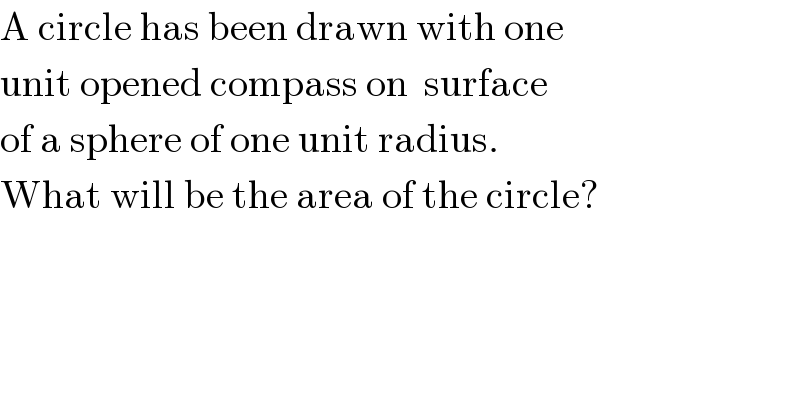
$$\mathrm{A}\:\mathrm{circle}\:\mathrm{has}\:\mathrm{been}\:\mathrm{drawn}\:\mathrm{with}\:\mathrm{one} \\ $$$$\mathrm{unit}\:\mathrm{opened}\:\mathrm{compass}\:\mathrm{on}\:\:\mathrm{surface} \\ $$$$\mathrm{of}\:\mathrm{a}\:\mathrm{sphere}\:\mathrm{of}\:\mathrm{one}\:\mathrm{unit}\:\mathrm{radius}.\: \\ $$$$\mathrm{What}\:\mathrm{will}\:\mathrm{be}\:\mathrm{the}\:\mathrm{area}\:\mathrm{of}\:\mathrm{the}\:\mathrm{circle}? \\ $$
Commented by Yozzii last updated on 05/May/16

$${A}=\mathrm{0}.\mathrm{75}\pi \\ $$
Commented by Yozzii last updated on 05/May/16
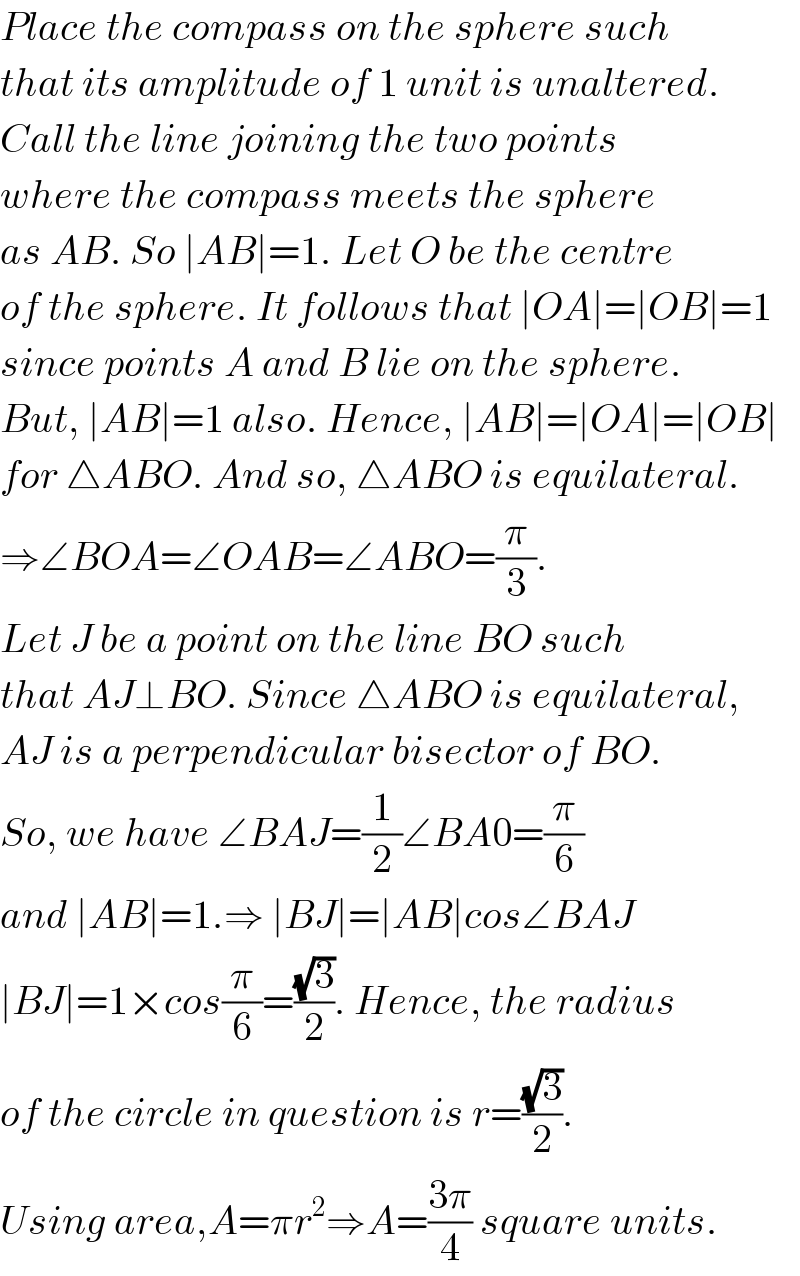
$${Place}\:{the}\:{compass}\:{on}\:{the}\:{sphere}\:{such} \\ $$$${that}\:{its}\:{amplitude}\:{of}\:\mathrm{1}\:{unit}\:{is}\:{unaltered}. \\ $$$${Call}\:{the}\:{line}\:{joining}\:{the}\:{two}\:{points} \\ $$$${where}\:{the}\:{compass}\:{meets}\:{the}\:{sphere}\: \\ $$$${as}\:{AB}.\:{So}\:\mid{AB}\mid=\mathrm{1}.\:{Let}\:{O}\:{be}\:{the}\:{centre} \\ $$$${of}\:{the}\:{sphere}.\:{It}\:{follows}\:{that}\:\mid{OA}\mid=\mid{OB}\mid=\mathrm{1} \\ $$$${since}\:{points}\:{A}\:{and}\:{B}\:{lie}\:{on}\:{the}\:{sphere}. \\ $$$${But},\:\mid{AB}\mid=\mathrm{1}\:{also}.\:{Hence},\:\mid{AB}\mid=\mid{OA}\mid=\mid{OB}\mid \\ $$$${for}\:\bigtriangleup{ABO}.\:{And}\:{so},\:\bigtriangleup{ABO}\:{is}\:{equilateral}. \\ $$$$\Rightarrow\angle{BOA}=\angle{OAB}=\angle{ABO}=\frac{\pi}{\mathrm{3}}.\: \\ $$$${Let}\:{J}\:{be}\:{a}\:{point}\:{on}\:{the}\:{line}\:{BO}\:{such} \\ $$$${that}\:{AJ}\bot{BO}.\:{Since}\:\bigtriangleup{ABO}\:{is}\:{equilateral}, \\ $$$${AJ}\:{is}\:{a}\:{perpendicular}\:{bisector}\:{of}\:{BO}. \\ $$$${So},\:{we}\:{have}\:\angle{BAJ}=\frac{\mathrm{1}}{\mathrm{2}}\angle{BA}\mathrm{0}=\frac{\pi}{\mathrm{6}} \\ $$$${and}\:\mid{AB}\mid=\mathrm{1}.\Rightarrow\:\mid{BJ}\mid=\mid{AB}\mid{cos}\angle{BAJ} \\ $$$$\mid{BJ}\mid=\mathrm{1}×{cos}\frac{\pi}{\mathrm{6}}=\frac{\sqrt{\mathrm{3}}}{\mathrm{2}}.\:{Hence},\:{the}\:{radius} \\ $$$${of}\:{the}\:{circle}\:{in}\:{question}\:{is}\:{r}=\frac{\sqrt{\mathrm{3}}}{\mathrm{2}}. \\ $$$${Using}\:{area},{A}=\pi{r}^{\mathrm{2}} \Rightarrow{A}=\frac{\mathrm{3}\pi}{\mathrm{4}}\:{square}\:{units}. \\ $$
Commented by Rasheed Soomro last updated on 05/May/16
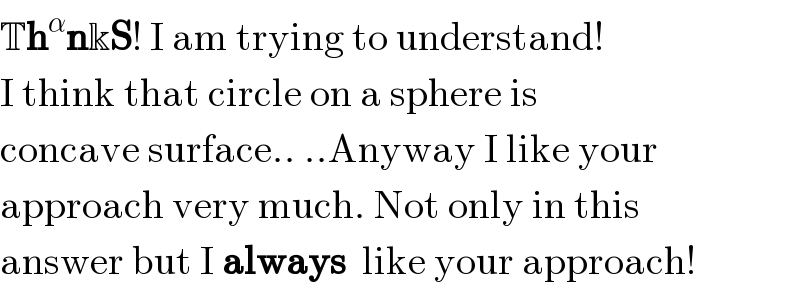
$$\mathbb{T}\boldsymbol{\mathrm{h}}^{\alpha} \boldsymbol{\mathrm{n}}\Bbbk\boldsymbol{\mathrm{S}}!\:\mathrm{I}\:\mathrm{am}\:\mathrm{trying}\:\mathrm{to}\:\mathrm{understand}! \\ $$$$\mathrm{I}\:\mathrm{think}\:\mathrm{that}\:\mathrm{circle}\:\mathrm{on}\:\mathrm{a}\:\mathrm{sphere}\:\mathrm{is} \\ $$$$\mathrm{concave}\:\mathrm{surface}..\:..\mathrm{Anyway}\:\mathrm{I}\:\mathrm{like}\:\mathrm{your} \\ $$$$\mathrm{approach}\:\mathrm{very}\:\mathrm{much}.\:\mathrm{Not}\:\mathrm{only}\:\mathrm{in}\:\mathrm{this} \\ $$$$\mathrm{answer}\:\mathrm{but}\:\mathrm{I}\:\boldsymbol{\mathrm{always}}\:\:\mathrm{like}\:\mathrm{your}\:\mathrm{approach}! \\ $$
Commented by Yozzii last updated on 05/May/16
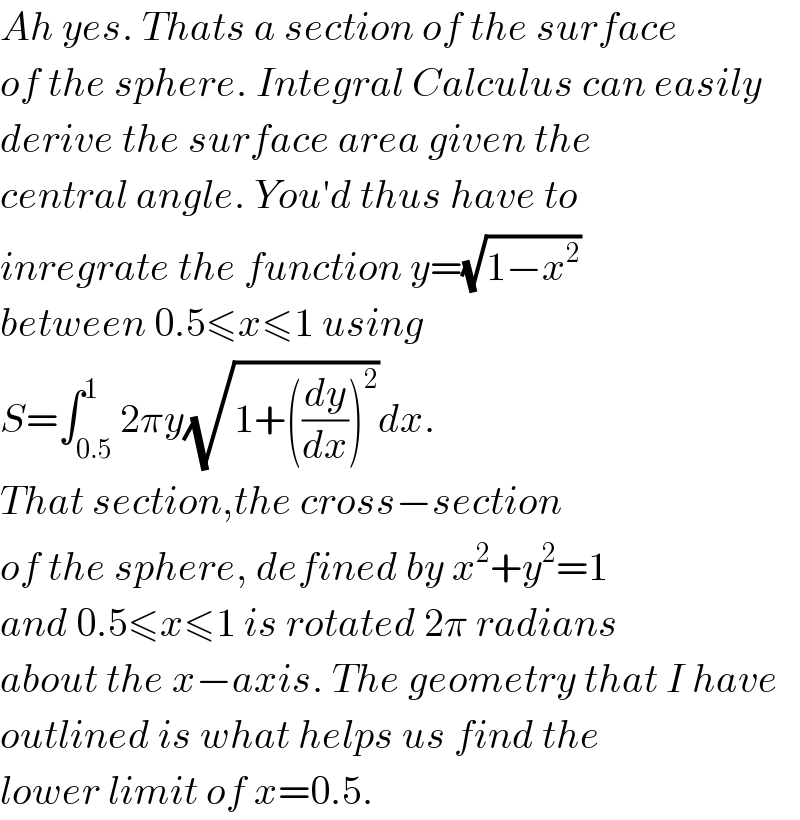
$${Ah}\:{yes}.\:{Thats}\:{a}\:{section}\:{of}\:{the}\:{surface} \\ $$$${of}\:{the}\:{sphere}.\:{Integral}\:{Calculus}\:{can}\:{easily} \\ $$$${derive}\:{the}\:{surface}\:{area}\:{given}\:{the} \\ $$$${central}\:{angle}.\:{You}'{d}\:{thus}\:{have}\:{to} \\ $$$${inregrate}\:{the}\:{function}\:{y}=\sqrt{\mathrm{1}−{x}^{\mathrm{2}} } \\ $$$${between}\:\mathrm{0}.\mathrm{5}\leqslant{x}\leqslant\mathrm{1}\:{using} \\ $$$${S}=\int_{\mathrm{0}.\mathrm{5}} ^{\mathrm{1}} \mathrm{2}\pi{y}\sqrt{\mathrm{1}+\left(\frac{{dy}}{{dx}}\right)^{\mathrm{2}} }{dx}. \\ $$$${That}\:{section},{the}\:{cross}−{section} \\ $$$${of}\:{the}\:{sphere},\:{defined}\:{by}\:{x}^{\mathrm{2}} +{y}^{\mathrm{2}} =\mathrm{1} \\ $$$${and}\:\mathrm{0}.\mathrm{5}\leqslant{x}\leqslant\mathrm{1}\:{is}\:{rotated}\:\mathrm{2}\pi\:{radians} \\ $$$${about}\:{the}\:{x}−{axis}.\:{The}\:{geometry}\:{that}\:{I}\:{have} \\ $$$${outlined}\:{is}\:{what}\:{helps}\:{us}\:{find}\:{the} \\ $$$${lower}\:{limit}\:{of}\:{x}=\mathrm{0}.\mathrm{5}. \\ $$
Commented by Yozzii last updated on 05/May/16

$${What}\:{my}\:{initial}\:{answer}\:{gave}\:{was} \\ $$$${the}\:{area}\:{of}\:{the}\:{region}\:{of}\:{a}\:{planar} \\ $$$${cut}\:{of}\:{the}\:{sphere}\:{in}\:{the}\:{circle}\:{generated} \\ $$$${by}\:{the}\:{compass}. \\ $$
Commented by Rasheed Soomro last updated on 05/May/16

$$\boldsymbol{\mathrm{ThankS}}\:\boldsymbol{\mathrm{again}}! \\ $$
Commented by Yozzii last updated on 05/May/16
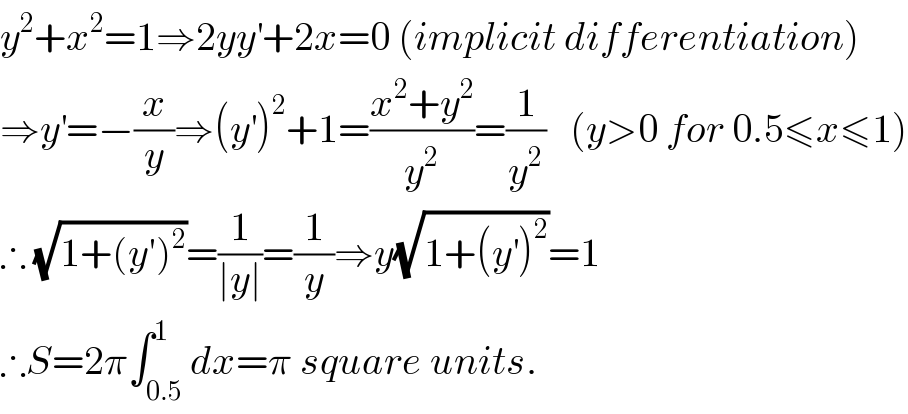
$${y}^{\mathrm{2}} +{x}^{\mathrm{2}} =\mathrm{1}\Rightarrow\mathrm{2}{yy}^{'} +\mathrm{2}{x}=\mathrm{0}\:\left({implicit}\:{differentiation}\right) \\ $$$$\Rightarrow{y}^{'} =−\frac{{x}}{{y}}\Rightarrow\left({y}^{'} \right)^{\mathrm{2}} +\mathrm{1}=\frac{{x}^{\mathrm{2}} +{y}^{\mathrm{2}} }{{y}^{\mathrm{2}} }=\frac{\mathrm{1}}{{y}^{\mathrm{2}} }\:\:\:\left({y}>\mathrm{0}\:{for}\:\mathrm{0}.\mathrm{5}\leqslant{x}\leqslant\mathrm{1}\right) \\ $$$$\therefore\:\sqrt{\mathrm{1}+\left({y}'\right)^{\mathrm{2}} }=\frac{\mathrm{1}}{\mid{y}\mid}=\frac{\mathrm{1}}{{y}}\Rightarrow{y}\sqrt{\mathrm{1}+\left({y}^{'} \right)^{\mathrm{2}} }=\mathrm{1} \\ $$$$\therefore{S}=\mathrm{2}\pi\int_{\mathrm{0}.\mathrm{5}} ^{\mathrm{1}} {dx}=\pi\:{square}\:{units}. \\ $$
Commented by Yozzii last updated on 05/May/16
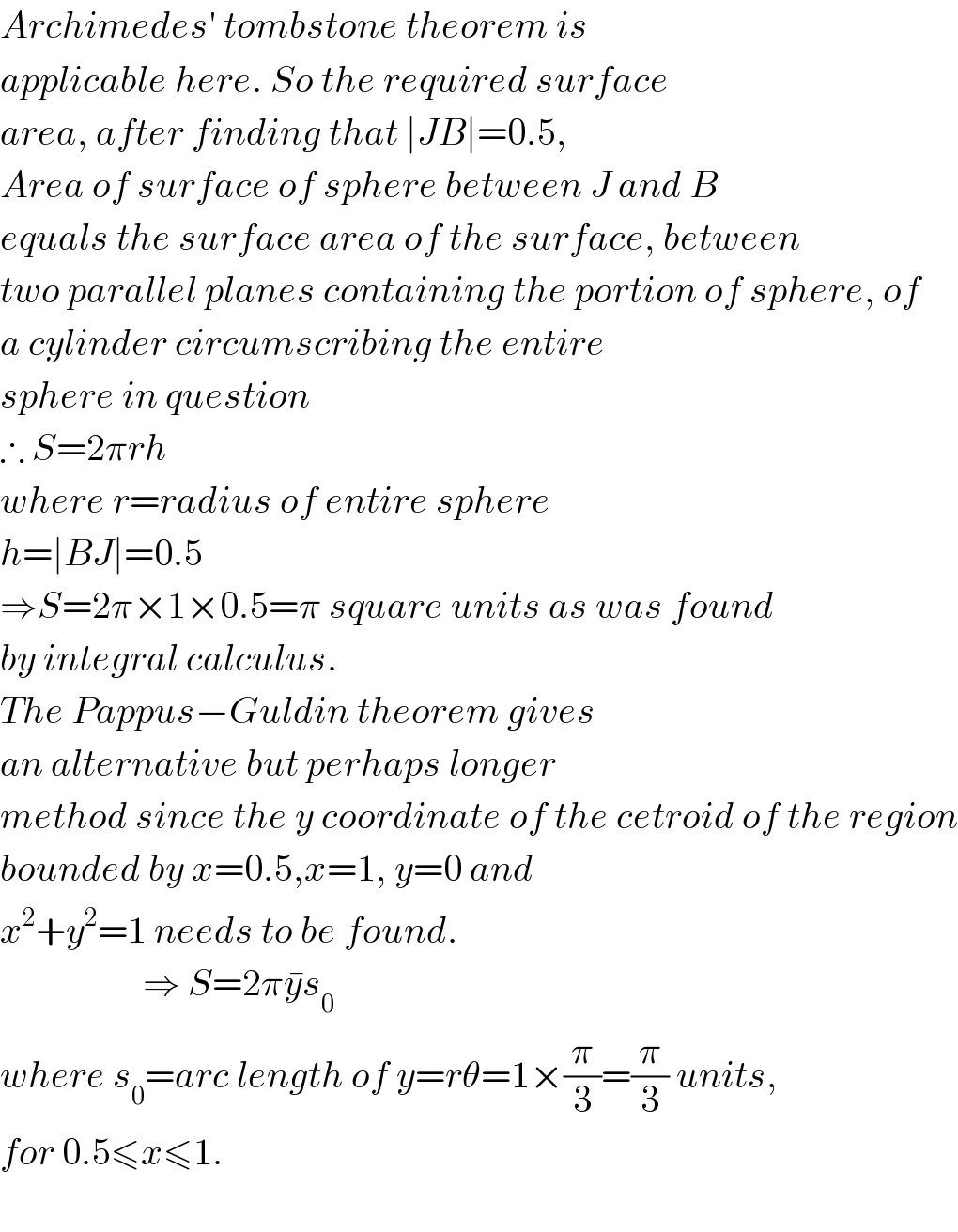
$${Archimedes}'\:{tombstone}\:{theorem}\:{is} \\ $$$${applicable}\:{here}.\:{So}\:{the}\:{required}\:{surface} \\ $$$${area},\:{after}\:{finding}\:{that}\:\mid{JB}\mid=\mathrm{0}.\mathrm{5}, \\ $$$${Area}\:{of}\:{surface}\:{of}\:{sphere}\:{between}\:{J}\:{and}\:{B} \\ $$$${equals}\:{the}\:{surface}\:{area}\:{of}\:{the}\:{surface},\:{between} \\ $$$${two}\:{parallel}\:{planes}\:{containing}\:{the}\:{portion}\:{of}\:{sphere},\:{of} \\ $$$${a}\:{cylinder}\:{circumscribing}\:{the}\:{entire} \\ $$$${sphere}\:{in}\:{question} \\ $$$$\therefore\:{S}=\mathrm{2}\pi{rh} \\ $$$${where}\:{r}={radius}\:{of}\:{entire}\:{sphere} \\ $$$${h}=\mid{BJ}\mid=\mathrm{0}.\mathrm{5} \\ $$$$\Rightarrow{S}=\mathrm{2}\pi×\mathrm{1}×\mathrm{0}.\mathrm{5}=\pi\:{square}\:{units}\:{as}\:{was}\:{found} \\ $$$${by}\:{integral}\:{calculus}.\: \\ $$$${The}\:{Pappus}−{Guldin}\:{theorem}\:{gives} \\ $$$${an}\:{alternative}\:{but}\:{perhaps}\:{longer}\: \\ $$$${method}\:{since}\:{the}\:{y}\:{coordinate}\:{of}\:{the}\:{cetroid}\:{of}\:{the}\:{region} \\ $$$${bounded}\:{by}\:{x}=\mathrm{0}.\mathrm{5},{x}=\mathrm{1},\:{y}=\mathrm{0}\:{and} \\ $$$${x}^{\mathrm{2}} +{y}^{\mathrm{2}} =\mathrm{1}\:{needs}\:{to}\:{be}\:{found}. \\ $$$$\:\:\:\:\:\:\:\:\:\:\:\:\:\:\:\:\:\:\:\Rightarrow\:{S}=\mathrm{2}\pi\bar {{y}s}_{\mathrm{0}} \\ $$$${where}\:{s}_{\mathrm{0}} ={arc}\:{length}\:{of}\:{y}={r}\theta=\mathrm{1}×\frac{\pi}{\mathrm{3}}=\frac{\pi}{\mathrm{3}}\:{units}, \\ $$$${for}\:\mathrm{0}.\mathrm{5}\leqslant{x}\leqslant\mathrm{1}. \\ $$$$ \\ $$
Commented by Rasheed Soomro last updated on 06/May/16

$$\mathbb{LOT}\:\mathcal{OF}\:\mathrm{Knowledge}! \\ $$$$\mathbb{LOT}\:\mathcal{OF}\:\:\mathbb{T}\mathrm{han}\Bbbk\mathcal{S}! \\ $$$$ \\ $$
